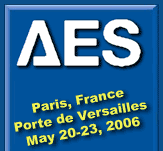

Home | Technical Program | Exhibition | Visitors | Students | Press
Last Updated: 20060404, mei
P30 - Posters: Instrumentation and MeasurementTuesday, May 23, 14:00 — 15:30
P30-1 A New Integrated System for Laboratory Speech/Voice Examination—Costas Pastiadis, Aristotle University of Thessaloniki - Thessaloniki, Greece; Georgia Psyllidou, Paris Telecom - Paris, France; George Papanikolaou, Aristotle University of Thessaloniki - Thessaloniki, Greece
The paper presents a new computer-based system for the examination and analysis of speech/voice functionality in laboratory environments. Although the system is mainly designed for clinical applications, it employs features that afford its generalized use as a speech/voice acquisition, analysis, and evaluation tool. The system offers an integrated and interactive modular structure for the conduction of various speech/voice examination procedures, and provides necessary data management capabilities for further exploitation in diagnostic expert systems and knowledge-based speech/voice applications.
[Poster Presentation Associated with Paper Presentation P25-2]
Convention Paper 6828 (Purchase now)
P30-2 Directivity Measurements on a Highly Directive Hearing Aid: The Hearing Glasses—Marinus Boone, Technical University of Delft - Delft, The Netherlands
A highly directional hearing aid has been developed with the aim to give a much higher speech intelligibility than with conventional hearing aids. The high directivity is obtained by mounting four microphones in each temple of a pair of glasses and performing optimized beam forming. This leads to an averaged directivity index of 9 dB under free field conditions, without head disturbance. In a recent research program the directivity of this device has been measured with different directivity settings under free field and diffuse field conditions, with and without head diffraction. Results are presented of this research, where a comparison will also be made with the directivity of a conventional hearing aid. Also, the influence of the setting of the superdirective beamforming on the noise sensitivity is shown, indicating that for practical use the directivity should be limited.
[Poster Presentation Associated with Paper Presentation P25-3]
Convention Paper 6829 (Purchase now)
P30-3 The Self-Compensated Audio Transformers for Tube and Solid State Single-Ended Amplifiers—Aristide Polisois, A2B Electronic - La Houssaye en Brie, France; Giovanni Mariani, GRAAF srl - Modena, Italy
The self-compensated output transformer presented at the AES Convention held in Barcelona in May 2005 (Convention Paper 6346), intended for single-ended audio amplifiers, is based on the principle that an auxiliary winding (named tertiary), crossed by the same current as the primary winding, can oppose a magnetic flux that reduces the overall flux, produced by the direct current, in the core, to almost zero. However, at the same time, this antagonist winding also opposes the induced alternating current. A capacitor is therefore connected to its terminals, short-circuiting the alternating current. Under these circumstances, the alternating potential difference is close to zero and the primary is no less affected. But the above short-circuit has a drawback: it reduces the inductance of the primary, considerably. Novel solutions have been found to remove this obstacle to a satisfactory performance of the self-compensated output transformer.
[Poster Presentation Associated with Paper Presentation P25-5]
Convention Paper 6831 (Purchase now)
P30-4 Room Impulse Response Measurement Using a Moving Microphone—Thibaut Ajdler, Luciano Sbaiz, Ecole Polytechnique Fédérale de Lausanne (EPFL) - Lausanne, Switzerland; Martin Vetterli, Ecole Polytechnique Fédérale de Lausanne (EPFL) - Lausanne, Switzerland, and University of California at Berkeley, Berkeley, CA, USA
In this paper we present a technique to record a large set of room impulse responses using a microphone moving along a trajectory. The technique processes the signal recorded by the microphone to reconstruct the signals that would have been recorded at all the possible spatial positions along the array. The speed of movement of the microphone is shown to be the key factor for the reconstruction. This fast method of recording spatial impulse responses can also be applied for the recording of head-related transfer functions.
[Poster Presentation Associated with Paper Presentation P25-8]
Convention Paper 6834 (Purchase now)